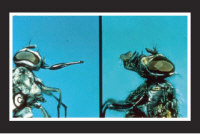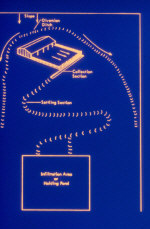



Sanitation for Fly and Disease Management at Confined Livestock Facilities
By John B. Campbell, Extension and Research Entomologist - Duane Rice, Extension Veterinarian. Published by University of Nebraska. This NebGuide describes flies found in confined livestock facilities, how they breed, and how they can be controlled.
Flies
The stable fly and house fly are the major insect pests at confined livestock units. The stable fly has a piercing-type mouthpart which is used to pierce the skin to obtain a blood meal. House flies do not bite because they have a sponging-type mouthpart with which they feed on semi-liquid material. The life cycles of the two species are similar, consisting of eggs, larvae (maggots), pupae, and the adult. During summer months the stable fly completes its life cycle in about three weeks and the house fly in about two weeks. Both species deposit eggs in wet, decaying organic matter. This includes spilled livestock feed and manure mixed with soil and moisture. In addition, the house fly will breed in fresh manure. The two species generally overwinter as slowly developing larvae in breeding areas below the frost line. The house fly may breed during the winter in warm buildings if breeding material is present.Cattle under attack by stable flies will bunch together with each animal attempting to find a position within the bunch which protects their front legs—the favored feeding site of the flies. Considerable energy is expended by foot stomping, tail switching, and throwing the head down toward the front legs in an effort to dislodge the flies or prevent feeding.
 |
 |
|
Generalized fly life cycle: eggs, larvae, pupae, adult |
A stable fly and a house fly. |
|---|
House flies have not been shown to reduce animal weight gain and feed efficiency but are known to transmit several animal diseases. The disease organisms recovered from house flies range from viruses to nematodes. The most common of these are the bacteria associated with enteric infections. The house fly mouthparts and feeding habits (filth sources) make it efficient in transmitting bacterial and viral agents. Over 100 different disease organisms have been recovered from house flies, and the fly has been implicated in the transmission of 65 of these. Transmission may simply involve the mechanical transfer of the disease agent from the mouthparts or body of the fly to the animal host. In other cases, the disease agent may multiply in the fly and be transmitted after populations of the disease agent build up to high numbers or it changes to a different life stage.
Stable flies, because of their blood-feeding habits, have also been suspected of transmitting diseases, but most research in disease transmission studies with the stable fly have proven negative. Mastitis in dairy herds is one of the exceptions. The mastitis organisms are routinely spread by the stable fly to the teat ends of heifers or lactating cows. Mastitis, the most costly disease of dairy cattle, is caused when the bacteria invade the teat and gain entrance to the mammary gland.
One other important economic factor associated with stable flies and house flies is the threat of nuisance lawsuits. Generally odor, dust, and flies are cited together as constituting a nuisance by the plaintiffs. The lawsuit may seek damages or, perhaps worse, request closing of the livestock facility.
Effective house fly and stable fly control cannot be achieved with insecticides alone. Proper animal manure management and sanitation must be the major element in a good fly control program. Confined livestock facilities should be designed or modified to facilitate ease in cleaning and to minimize accumulations of manure, spilled feed and other sources of organic debris.
Breeding Areas
In feedlots, major fly breeding areas include: 1) fence lines where manure mixed with wet soil accumulates; 2) along feeding aprons where, because of the slope of the aprons, moisture and manure accumulate; 3) at the edges of potholes, in pen corners, and around gates; 4) along pen drainage channels or edges of holding ponds at the water-soil interface unless it is sloped enough to drain and dry quickly; 5) along the sloping edges of mounds where moisture runoff occurs; 6) around waterers if leakage or spillage occurs; 7) at the edge of and under feed bunks; 8) in and around feed handling facilities if the feed becomes wet; 9) at the edges of stored manure, if the edges are loosely packed and wet; and 10) at the edge of silage and haylage.
In addition, excessive moisture may provide fly-breeding areas under round bales in and around old hay or straw stack butts and in sick pens and horse stables if hay or straw bedding is used.
Fly breeding areas at dairies might include any of the areas described for feedlots, but fly breeding might also occur under and around self-feeding forage racks and in calf hutches or pens where hay or straw bedding is used.
Fly breeding at swine units is restricted primarily to the house fly. Stable flies will breed in wet, spilled feed around swine units but are rarely, if ever, found breeding in wet soil-swine manure mixtures as is the house fly. The most common fly breeding areas will differ to some extent with the type of facility but basically occur at any location where swine manure or wet feed stuffs are allowed to remain for a period of 10-14 days. In swine confinement buildings, where manure is collected below the slatted floor pens, a crust occasionally occurs unless some type of agitation is provided. House flies may breed in the crust just below the surface. Agitation provided by the manure dropping from the slatted floor will suffice if enough liquid is available and the depth of the drop is greater than one foot. Manure may also accumulate in the upper corners just below the slatted floors. The same situation is true for cattle confinement buildings. In modified open front or open lots, the main fly breeding areas may be under and around the self-feeders or in the corners of the facility. While the accumulation of the manure or spilled feed may be relatively small, an area about a square yard in size will allow several thousand flies to develop in a period of two to three weeks.
Fly Management
 |
|
Feedlot Pest Management
|
Reduction of fly breeding areas in feedlots is dependent primarily on manure management and keeping the lots dry. Mounds are a key element in this process. They should be built and maintained to provide a dry area for the cattle and drainage for the excess moisture to move from the pens to the drainage system. During wet periods, the wet edges of the mounds can be scraped into the lot in a thin layer to facilitate rapid drying.
Maximum stocking rates create tramping action that helps in drying. The lots also can be dragged periodically which helps maintain a dry surface. The area behind the feeding apron should be scraped at two week intervals and the manure either removed or spread out in the lot for rapid drying. Drainage systems should be maintained with enough slope to move the moisture to the holding ponds rapidly which allows for rapid drying as well.
Haylage and silage piles may have drainage at the edges. The seepage provides an excellent fly-breeding site. Covering this seepage area with black plastic should create enough heat to kill the developing fly larvae.
If manure is used as fertilizer and spread directly on farm fields, care should be taken to spread the manure thin enough for rapid drying. If the manure is spread at depths of three to four inches or more and enough moisture is present, it may allow fly breeding.
Water tanks should be surrounded by a concrete apron and equipped with a drain line to facilitate cleaning without creating a muddy area in the lot. Float valves on waterers should be protected to prevent animals from causing an overflow. Livestock pens usually have enough organic matter present to create a fly breeding area wherever water accumulates.
Feedlots designed or modified to meet the Environmental Protection Agency?s pollution runoff standards can have an additional fly breeding area in the debris basin. The purpose of the debris basin is to intercept the feedlot runoff, allow the solids to settle and channel the liquids into the holding pond. The basin should be sloped enough to prevent water from standing and provide quick drying. Solids should be removed regularly to prevent fly breeding.
If spray mists are used to cool cattle or hogs or to settle dust, care should be taken to prevent puddles from forming. Dragging the surface of the lot may fill in low areas where puddles form.
Each livestock unit is different and there may be fly breeding occurring in only two or three locations. However, since even small amounts of fly-breeding material can support large numbers of flies, these areas should be located and removed. Manure management and sanitation can be expensive but should be considered a required management practice in livestock production. The benefits (better animal performance, more efficient use of insecticides, better working conditions for employees, more attractive facility for commercial customers, reduced risk of nuisance lawsuits, and reduced chances of disease outbreaks) may offset the expense.



